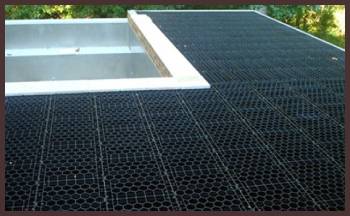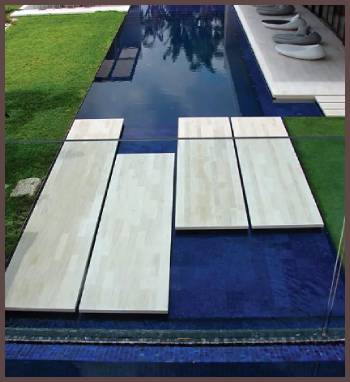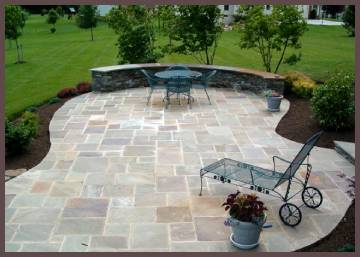Have you ever found yourself wistfully dreaming of a gorgeous stone deck but dread the thought of the demanding maintenance and cost that wooden decks bring? You might have come across the innovative solution called Silca Grate.
Although Silca Grate has offered a compelling solution, it is essential to look at the broader picture and explore viable alternatives to Silca Grate.
A Brief Overview of Silca Grate

Let’s first understand the product we’re trying to find alternatives to. Silca Grate is a revolutionary sub-flooring system that enables you to convert a wooden deck into a stone deck. This approach expands the possibilities for decking materials beyond traditional wood and composite materials, allowing homeowners to use durable, long-lasting stone or brick.
However, let’s address the elephant in the room – cost.
How much does the Silca system cost?
Silca System is more expensive than traditional wooden decks. The exact cost varies depending on the size of your deck and the stone material you choose, but you can expect to spend several times more than a standard wood deck.
Read More: About Cumaru Wood Flooring

Exploring Pervious Decking Materials
What are the materials used in pervious decking?
Pervious decking utilizes materials that allow water to seep through, preventing water pooling and reducing runoff. These materials include porous concrete, interlocking pavers, and rubber decking. They offer a balance of durability and permeability, making them excellent alternatives to Silca Grate for eco-conscious homeowners.
The Stone Deck Transformation
Can you cover a wood deck with stone?
Yes, you can! But, you don’t always need a Silca Grate to do it. A great alternative is a deck tile system.
Using Deck Tiles over Existing Decks

Can you put deck tiles over an existing deck?
Absolutely! Deck tiles, often made of composite materials, can be installed over an existing deck, providing a fresh look and extra durability. They’re available in a variety of styles, including those that imitate stone’s aesthetic. What’s even better is that installing deck tiles is a do-it-yourself-friendly project, which could be appealing if you’re keen on saving labor costs.
What Goes Underneath the Deck Matters
Should I put gravel or stone under the deck?
Using gravel or stone underneath your deck can serve multiple purposes. These materials can provide additional drainage and prevent weeds from growing. The choice between gravel and stone depends on your preferences and budget. Both are viable options, with gravel generally being cheaper but stone offering a more premium aesthetic.
The Cost Factor: Stone vs. Wood Deck
What is cheaper stone or wood deck?
Typically, a wooden deck is cheaper upfront than a stone deck. However, the long-term costs may lean in favor of stone decks due to their durability and lower maintenance needs. While the initial cost of installing a stone deck (especially with systems like Silca Grate) might seem high, you could save money in the long run on maintenance and replacement costs. But let’s not dismiss the alternatives that offer a balance between cost, durability, and aesthetic appeal.
Read More: About Cumaru Wood Flooring
Frequently Asked Questions (FAQs)
The Silca System can be quite expensive, with costs varying based on deck size and chosen stone materials. Expect to pay significantly more than you would for a traditional wood deck.
Pervious decking materials often include porous concrete, interlocking pavers, and rubber decking. These materials allow water to pass through, promoting drainage and minimizing runoff.
Absolutely! Covering a wood deck with stone is possible and can be achieved through various methods. Silca Grate is one option, but deck tile systems offer an alternative that is easier to install and more cost-effective.
Yes, you can. Deck tiles are designed to be installed over existing decks, providing a quick and simple way to transform your deck’s appearance. These tiles often come in composite materials that mimic the look of stone, giving you the aesthetic appeal you desire.
Both gravel and stone can be used as a base material under your deck. They offer additional drainage and help prevent weed growth. Gravel is generally cheaper, while stone provides a more high-end look. The choice depends on your preferences and budget.
In terms of upfront costs, wood decks are usually cheaper than stone decks. However, when considering long-term expenses, stone decks may prove more cost-effective due to their durability and lower maintenance requirements. While systems like Silca Grate can be expensive initially, they can save you money in the long run by reducing maintenance and replacement costs.
In conclusion, while Silca Grate has its merits, it’s important to explore alternatives when considering a stone deck. Pervious decking materials like porous concrete, interlocking pavers, and rubber decking offer durability and permeability. Deck tile systems provide a simpler and more cost-effective way to achieve a stone deck appearance. By comparing cost, installation complexity, aesthetics, and longevity, you can find an alternative that suits your preferences and budget. So, go ahead and explore the world of alternatives to Silca Grate to create your dream deck without breaking the bank.
Final Thoughts
While Silca Grate has offered homeowners a pathway to elegant stone decks, it isn’t the only player in the game. Alternatives such as deck tiles and pervious decking materials are making waves in the industry, offering cost-effective, durable, and attractive options for homeowners who want the luxury of a stone deck without the price tag of Silca Grate.
It’s crucial to weigh these alternatives to Silca Grate in terms of cost, installation complexity, aesthetic appeal, and longevity to make an informed decision that suits your specific needs and preferences. By exploring these alternatives, you can find a solution that aligns with your budget, style, and environmental considerations.



